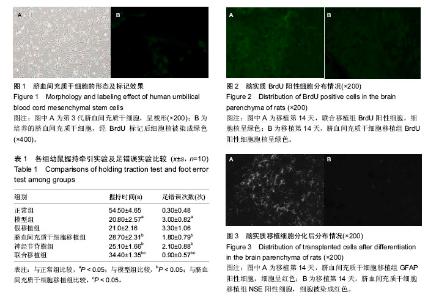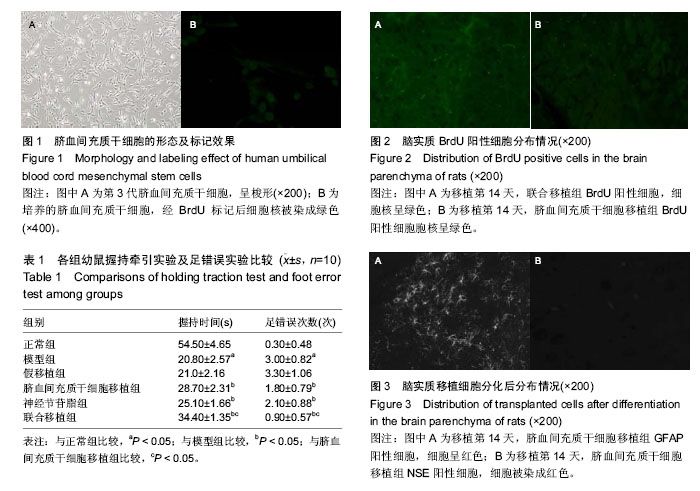Chinese Journal of Tissue Engineering Research ›› 2016, Vol. 20 ›› Issue (19): 2803-2809.doi: 10.3969/j.issn.2095-4344.2016.19.010
Previous Articles Next Articles
Human umbilical blood cord mesenchymal stem cell transplantation combined with injection of ganglioside for cerebral palsy
Yang Zi-jin, Guo Jia-li, Lu Si-guang, Gao Chang-long, Li Hong-mei, Feng Yue
- Department of Pediatrics, First People’s Hospital of Lianyungang, Lianyungang 222000, Jiangsu Province, China
-
Received:2016-03-14Online:2016-05-06Published:2016-05-06 -
About author:Yang Zi-jin, Master, Chief physician, Master’s supervisor, Department of Pediatrics, First People’s Hospital of Lianyungang, Lianyungang 222000, Jiangsu Province, China -
Supported by:the Key Department Construction Project of Lianyungang Municipal Science and Technology Bureau in Jiangsu, No. SH1117
CLC Number:
Cite this article
Yang Zi-jin, Guo Jia-li, Lu Si-guang, Gao Chang-long, Li Hong-mei, Feng Yue. Human umbilical blood cord mesenchymal stem cell transplantation combined with injection of ganglioside for cerebral palsy[J]. Chinese Journal of Tissue Engineering Research, 2016, 20(19): 2803-2809.
share this article

2.1 脐血间充质干细胞的培养及鉴定 复苏后细胞生长旺盛,呈形态及大小均一的小长梭形细胞(图1A),折光性强,倍增时间为5-9 d,约1周融合。细胞传3代后,应用流式细胞仪进行脐血间充质干细胞表面标志性抗原检测,结果显示脐血间充质干细胞高表达CD29(68.2%)、CD44(52.2%)和CD105(65.7%)表面标志, 低表达CD34(3.6%)和CD45(1.0%)表面标志,符合间充质干细胞特征。 2.2 培养细胞免疫荧光结果 BrdU标记脐血间充质干细胞72 h,细胞爬片后,应用直接免疫荧光法检测BrdU阳性细胞率,大部分细胞核被染成鲜绿色(图1B),标记率为93%,说明培养的脐血间充质干细胞标记成功。 2.3 脑瘫模型制作结果 对生后4周的幼鼠进行行为学检测,模型成功率约85%,随机选出符合脑瘫标准的大鼠60只。 2.4 神经行为学功能评定 2.4.1 握持牵引实验时间比较 与模型组比较,正常组握持时间明显延长,二者相比差异有显著性意义(P < 0.05),表明模型组大鼠较正常组握持能力明显下降,提示存在脑损伤。假移植组与模型组相比差异无显著性意义(P > 0.05),表明PBS及注射本身对脑瘫鼠无明显影响;脐血间充质干细胞移植组、神经节苷脂组、联合移植组握持时间均高于模型组,差异有显著性意义(P < 0.05),同时联合移植组握持时间高于脐血间充质干细胞移植组,二者相比差异有显著性意义(P < 0.05),表明脐血间充质干细胞移植及神经节苷脂均可改善脑瘫大鼠的握持能力,联合移植改善程度优于脐血间充质干细胞移植组,脐血间充质干细胞与神经节苷脂有一定协调作用,见表1。 2.4.2 足错误实验 模型组较正常组错误次数明显增多,且差异有显著性意义(P < 0.05),说明脑瘫模型制作成功,模型组大鼠造成了脑部损伤以致肢体运动协调能力发生障碍;假移植组及模型组二者无明显差异,说明移植手术本身对模型无明显影响。 脐血间充质干细胞移植组、联合移植组、神经节苷脂组分别与模型组相比,差异有显著性意义(P < 0.05),表明脐血间充质干细胞移植可提高脑瘫大鼠的肢体运动协调能力,且联合移植组优于脐血间充质干细胞组,差异有显著性意义(P < 0.05),表明脐血间充质干细胞及神经节苷脂二者有部分协调作用,能改善脑瘫大鼠部分功能,见表1。 2.5 脑实质BrdU阳性细胞迁移、分布、分化情况 应用免疫荧光单标染色,在荧光显微镜下,可见FITC标记的BrdU阳性细胞。人脐血间充质干细胞移植后大鼠脑实质BrdU阳性细胞主要分布在大脑皮质区、海马、脑室周围,有局部聚集现象,白质区、基底节、丘脑区可见少量BrdU阳性细胞。脐血间充质干细胞组移植后第7天大鼠脑组织内可见较多BrdU阳性细胞(28.3± 6.2),主要聚集在大脑皮质、侧脑室及嗅球,左侧(移植侧)多于右侧;第14天BrdU阳性细胞(20.6±3.6)、第21天BrdU阳性细胞(13.7±3.8)逐渐减少,主要分布在海马、侧脑室旁、基底节(图2),第28天仅见少量BrdU阳性细胞(6.2±2.1)存活。因GFAP抗体及NSE抗体一抗均为抗人抗体,GFAP、NSE分别存在于星形胶质细胞、神经元细胞中,故GFAP、NSE阳性细胞可视为移植细胞分化的星形胶质细胞、神经元细胞。移植14,28 d均可见到GFAP、NSE阳性细胞,但28 d时明显减少。 2.6 脐血间充质干细胞移植组及联合移植组脑实质阳性细胞对比 人脐血间充质干细胞移植第14天,联合移植组BrdU阳性细胞为(30.10±2.23)个/视野,高于脐血间充质干细胞移植组(20.00±2.79)个/视野,差异有显著性意义(t=10.28,P < 0.05);移植第14天,联合移植组GFAP阳性细胞为(17.90±1.52)个/视野,高于脐血间充质干细胞移植组(10.20±1.55)个/视野,差异有显著性意义(t=9.75,P < 0.05);联合移植组NSE阳性细胞为(7.00±1.82)个/视野,高于脐血间充质干细胞移植组(5.30±2.11)个/视野,差异无显著性意义(t=2.08,P > 0.05),见图3。移植28 d,两组BrdU、GFAP、NSE阳性细胞均明显减少,差异无显著性意义。"

| [1] 沈晓明,王卫平,常立文,等.儿科学[M].7版.北京:人民卫生出版社,2008:408-409.[2] 孙国军,赵文静,陈曦,等.脐血间充质干性的分离平培养及生物学特性[J].中国组织工程研究与临床康复,2011, 15(14):2504-2507.[3] 赵霞,路希敬,刘国强,等.不同培养基培养人脐血间充质干细胞的差异[J].中国组织工程研究,2013,17(19): 3447-3455.[4] 周志刚,李志忠,林永新,等.人脐血间充质干细胞定向诱导分化成类神经元的实验研究[J].中国病理生理杂志,2015, 31(2):229-233.[5] 陈镭,陈冰,谢福堂.诱导脐血间充质干细胞向神经元样细胞分化[J].中国组织工程研究,2012,16(23):4335-4338.[6] Divya MS, Roshin GE, Divya TS, et al. Umbilical cord blood-derived mesenchymal stem cells consist of a unique population of progenitors co-expressing mesenchymal stem cell and neuronal markers capable of instantaneous neuronal differentiation. Stem Cell Res Ther. 2012;3(6):57.[7] 王向野,张志友,杨小明,等.神经干细胞侧脑室内移植治疗脑瘫鼠的实验研究[J].中国临床神经外科杂志,2012, 17(6):354-357.[8] 谭洁璐,郑湘榕.脑性瘫痪动物模型的制作与鉴定研究进展[J].国际儿科学杂志,2010,37(5):494-496. [9] Wang Y, Liu Y, Liu Q. Ganglioside promotes the bridging of sciatic nerve defects in cryopreserved peripheral nerve allografts. Neural Regen Res. 2014; 9(20):1820-1823.[10] 李哲,王和强,刘兵,等.单唾液酸四己糖神经节苷脂钠注射液对痉挛性脑瘫的疗效[J].中国康复理论与实践,2015, 21(3):341-343.[11] 赵凯,贾宇臣.人脐血干细胞在局灶性脑缺血大鼠体内的迁移与分化[J].中国生物制品学杂志,2015,28(3): 286- 291.[12] 肖升平,马廉,罗敏洁,等.人脐带血间充质干细胞在缺氧缺血性脑病新生鼠脑内的定值[J].实用儿科临床杂志,2007, 22(21):1655-1657.[13] Castillo-Melendez M, Yawno T, Jenkin G, et al. Stem cell therapy to protect and repair the developing brain: a review of mechanisms of action of cord blood and amnion epithelial derived cells. Front Neurosci. 2013; 7:194.[14] Park SI, Lim JY, Jeong CH, et al. Human umbilical cord blood-derived mesenchymal stem cell therapy promotes functional recovery of contused rat spinal cord through enhancement of endogenous cell proliferation and oligogenesis. J Biomed Biotechnol. 2012;2012:362473.[15] Koh H,Hwang K,Lim HY,et al.Mononuclear cells from the cord blood and granulocyte- colony stimulating factor-mobilized peripheral blood: is there a potential for treatment of cerebral palsy? Neural Regen Res. 2015; 10 (12): 2018-2024.[16] Danby R, Rocha V. Improving engraftment and immune reconstitution in umbilical cord blood transplantation. Front Immunol. 20144;5:68.[17] Park HW, Moon HE, Kim HS, et al. Human umbilical cord blood-derived mesenchymal stem cells improve functional recovery through thrombospondin1, pantraxin3, and vascular endothelial growth factor in the ischemic rat brain. J Neurosci Res. 2015; 93(12): 1814-1825.[18] Koh SH, Kim KS, Choi MR, et al. Implantation of human umbilical cord-derived mesenchymal stem cells as a neuroprotective therapy for ischemic stroke in rats. Brain Res. 2008;1229:233-248.[19] Cui B, Li E, Yang B, et al. Human umbilical cord blood-derived mesenchymal stem cell transplantation for the treatment of spinal cord injury. Exp Ther Med. 2014;7(5):1233-1236.[20] Kim DH, Lee D, Chang EH, et al. GDF-15 secreted from human umbilical cord blood mesenchymal stem cells delivered through the cerebrospinal fluid promotes hippocampal neurogenesis and synaptic activity in an Alzheimer's disease model. Stem Cells Dev. 2015;24(20):2378-2390.[21] Zhu Y, Guan YM, Huang HL, et al. Human umbilical cord blood mesenchymal stem cell transplantation suppresses inflammatory responses and neuronal apoptosis during early stage of focal cerebral ischemia in rabbits. Acta Pharmacol Sin. 2014;35(5):585-591.[22] Chelluboina B, Klopfenstein JD, Pinson DM, et al. Stem cell treatment after cerebral ischemia regulates the gene expression of apoptotic molecules.Neurochem Res. 2014;39(8):1511-1521.[23] Park SI, Lim JY, Jeong CH, et al. Human umbilical cord blood-derived mesenchymal stem cell therapy promotes functional recovery of contused rat spinal cord through enhancement of endogenous cell proliferation and oligogenesis. J Biomed Biotechnol. 2012;2012:362473.[24] Fleiss B, Guillot PV, Titomanlio L, et al. Stem cell therapy for neonatal brain injury. Clin Perinatol. 2014; 41(1):133-148.[25] Koh SH, Kim KS, Choi MR, et al. Implantation of human umbilical cord-derived mesenchymal stem cells as a neuroprotective therapy for ischemic stroke in rats. Brain Res. 2008;1229:233-248.[26] Rafieemehr H, Kheirandish M, Soleimani M. Improving the neuronal differentiation efficiency of umbilical cord blood-derived mesenchymal stem cells cultivated under appropriate conditions. Iran J Basic Med Sci. 2015;18(11):1100-1106.[27] Hussain EK, Waheed IN. The Effects of Insulin Like Growth Factor -1 (IGF-1) on the Plasticity of Umbilical Cord Blood Derived Mesenchymal Stem Cells Colonies to In Vitro Neurogenic Differentiation. Journal of Biology, Agriculture and Healthcare. 2015; 5(4): 138-144.[28] Wang YD,Liu YG,Liu Q.Ganglioside promotes the bridging of sciatic nerve defects in cryopreserved peripheral nerve allografts. Neural Regen Res. 2014; 9(20): 1820-1823.[29] Nan C, Shi Y, Zhao Z, et al. Monosialoteterahexosyl ganglioside induces the differentiation of human umbilical cord-derived mesenchymal stem cells into neuron-like cells. Int J Mol Med. 2015;36(4): 1057-1062.[30] Zhang X, Zhang Q, Li W, et al. Therapeutic effect of human umbilical cord mesenchymal stem cells on neonatal rat hypoxic-ischemic encephalopathy. J Neurosci Res. 2014;92(1):35-45.[31] Tio M, Tan KH, Lee W, et al. Roles of db-cAMP, IBMX and RA in aspects of neural differentiation of cord blood derived mesenchymal-like stem cells. PLoS One. 2010;5(2):e9398.[32] Zhang ZJ, Li YJ, Liu XG, et al.Human umbilical cord blood stem cells and brain-derived neurotrophic factor for optic nerve injury: a biomechanical evaluation. Neural Regen Res. 2015; 10(7): 1134-1138.[33] Sypecka J, Sarnowska A. Mesenchymal cells of umbilical cord and umbilical cord blood as a source of human oligodendrocyte progenitors. Life Sci. 2015; 139:24-29. |
| [1] | Zhang Tongtong, Wang Zhonghua, Wen Jie, Song Yuxin, Liu Lin. Application of three-dimensional printing model in surgical resection and reconstruction of cervical tumor [J]. Chinese Journal of Tissue Engineering Research, 2021, 25(9): 1335-1339. |
| [2] | Zeng Yanhua, Hao Yanlei. In vitro culture and purification of Schwann cells: a systematic review [J]. Chinese Journal of Tissue Engineering Research, 2021, 25(7): 1135-1141. |
| [3] | Xu Dongzi, Zhang Ting, Ouyang Zhaolian. The global competitive situation of cardiac tissue engineering based on patent analysis [J]. Chinese Journal of Tissue Engineering Research, 2021, 25(5): 807-812. |
| [4] | Wu Zijian, Hu Zhaoduan, Xie Youqiong, Wang Feng, Li Jia, Li Bocun, Cai Guowei, Peng Rui. Three-dimensional printing technology and bone tissue engineering research: literature metrology and visual analysis of research hotspots [J]. Chinese Journal of Tissue Engineering Research, 2021, 25(4): 564-569. |
| [5] | Chang Wenliao, Zhao Jie, Sun Xiaoliang, Wang Kun, Wu Guofeng, Zhou Jian, Li Shuxiang, Sun Han. Material selection, theoretical design and biomimetic function of artificial periosteum [J]. Chinese Journal of Tissue Engineering Research, 2021, 25(4): 600-606. |
| [6] | Liu Fei, Cui Yutao, Liu He. Advantages and problems of local antibiotic delivery system in the treatment of osteomyelitis [J]. Chinese Journal of Tissue Engineering Research, 2021, 25(4): 614-620. |
| [7] | Li Xiaozhuang, Duan Hao, Wang Weizhou, Tang Zhihong, Wang Yanghao, He Fei. Application of bone tissue engineering materials in the treatment of bone defect diseases in vivo [J]. Chinese Journal of Tissue Engineering Research, 2021, 25(4): 626-631. |
| [8] | Zhang Zhenkun, Li Zhe, Li Ya, Wang Yingying, Wang Yaping, Zhou Xinkui, Ma Shanshan, Guan Fangxia. Application of alginate based hydrogels/dressings in wound healing: sustained, dynamic and sequential release [J]. Chinese Journal of Tissue Engineering Research, 2021, 25(4): 638-643. |
| [9] | Chen Jiana, Qiu Yanling, Nie Minhai, Liu Xuqian. Tissue engineering scaffolds in repairing oral and maxillofacial soft tissue defects [J]. Chinese Journal of Tissue Engineering Research, 2021, 25(4): 644-650. |
| [10] | Xing Hao, Zhang Yonghong, Wang Dong. Advantages and disadvantages of repairing large-segment bone defect [J]. Chinese Journal of Tissue Engineering Research, 2021, 25(3): 426-430. |
| [11] | Chen Siqi, Xian Debin, Xu Rongsheng, Qin Zhongjie, Zhang Lei, Xia Delin. Effects of bone marrow mesenchymal stem cells and human umbilical vein endothelial cells combined with hydroxyapatite-tricalcium phosphate scaffolds on early angiogenesis in skull defect repair in rats [J]. Chinese Journal of Tissue Engineering Research, 2021, 25(22): 3458-3465. |
| [12] | Wang Hao, Chen Mingxue, Li Junkang, Luo Xujiang, Peng Liqing, Li Huo, Huang Bo, Tian Guangzhao, Liu Shuyun, Sui Xiang, Huang Jingxiang, Guo Quanyi, Lu Xiaobo. Decellularized porcine skin matrix for tissue-engineered meniscus scaffold [J]. Chinese Journal of Tissue Engineering Research, 2021, 25(22): 3473-3478. |
| [13] | Mo Jianling, He Shaoru, Feng Bowen, Jian Minqiao, Zhang Xiaohui, Liu Caisheng, Liang Yijing, Liu Yumei, Chen Liang, Zhou Haiyu, Liu Yanhui. Forming prevascularized cell sheets and the expression of angiogenesis-related factors [J]. Chinese Journal of Tissue Engineering Research, 2021, 25(22): 3479-3486. |
| [14] | Liu Chang, Li Datong, Liu Yuan, Kong Lingbo, Guo Rui, Yang Lixue, Hao Dingjun, He Baorong. Poor efficacy after vertebral augmentation surgery of acute symptomatic thoracolumbar osteoporotic compression fracture: relationship with bone cement, bone mineral density, and adjacent fractures [J]. Chinese Journal of Tissue Engineering Research, 2021, 25(22): 3510-3516. |
| [15] | Liu Liyong, Zhou Lei. Research and development status and development trend of hydrogel in tissue engineering based on patent information [J]. Chinese Journal of Tissue Engineering Research, 2021, 25(22): 3527-3533. |
| Viewed | ||||||
|
Full text |
|
|||||
|
Abstract |
|
|||||